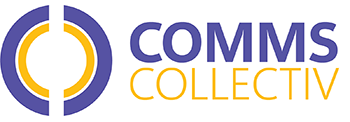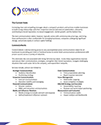CollectivNews
Welcome to a monthly round-up of information relevant
to comms professionals and everyone interested in the fractional model.
May 2025

Fractional Communications Leaders Are Having a Moment
Fractional executives aren’t a new idea — but they are just starting to make waves in the world of communications. While finance, technology, human resources and the C-suite have long benefited from this flexible model, many organizations are just beginning to realize the upside of applying the same approach to their communications function.
The data backs it up: Heidrick & Struggles’ Business Talent Group reports a 300%+ surge in interim executive placements since 2020 — and that figure may underestimate what’s actually happening in the field.
The reasons companies bring in fractional CFOs or CIOs sound a lot like what our clients are asking for when they call us:
Backfill a gap — from parental leave to leadership transitions that drag on
Bring in niche expertise — someone who’s seen this challenge before, from the inside
Tackle projects with no internal bandwidth — but that aren’t a fit for a traditional agency
Stand up a new function — or pressure-test an existing one
And that’s just the short list. The truth is, most use cases emerge in real time — when a client names a challenge they think is unique, but turns out to be tailor-made for a fractional solution.
The benefits are clear: seasoned expertise, scalable hours, and strategic insight without the full-time cost or commitment.
Fractional comms pros are not there to “plug holes.” They integrate into your team, elevate the conversation, and introduce new ways of thinking based on experience across industries and sectors. Can they execute? Of course. But more importantly, they’re collaborating, shaping, and sparking ideas that may not have surfaced otherwise.
In a moment where the stakes are high, fractional leadership is a win-win-win strategy.

Navigating Parental Leave with Fractional Support
By Meghan Biango
Raising three children certainly does not make me a parenting expert, but I am definitely a maternity leave pro! Navigating, planning, taking and then returning from a leave of absence in a corporate environment is extremely challenging, particularly in the field of communications when priorities shift on a daily (sometimes hourly) basis.
In my experience, planful and strategic interim support is one of the most meaningful ways to ensure the needs of the business are met at the highest level when a senior leader is on leave. That’s why I was so pleased to be brought on in a fractional capacity to support a fellow communications leader at a global apparel retailer while they were on parental leave the past six months.
Working part-time, about 24 hours a week, enabled me to be embedded in the organization while also providing the team moments to shine with stretch assignments. It was truly a win-win situation for all involved.
One of my main priorities was guiding junior team members – making sure they were asking the right questions, bringing solutions to leadership, and importantly, not getting burned out with increased workloads. I served as a sounding board, reviewer, writer and more. With my broad experience, I was a ‘plug and play’ leader, able to quickly get up to speed on brand voice and positioning to successfully support on issues management, message development and executive positioning.
For fast-moving organizations, bringing on fractional support to navigate parental leave is the best way to keep your communications team rolling! Reach out if you want to talk through maternity leave prep or compare notes on sleep schedules.
A member of CommsCollectiv talent pool, Meghan Biango is a seasoned communications leader with more than 15 years of experience within internal and external communications. Throughout her career, she has managed communications at a number of large, complex organizations, including Saks OFF 5TH, Toys “R” Us and The Vitamin Shoppe. She now brings this wealth of knowledge to her clients, helping them to develop impactful and forward-thinking communications strategies.

Responsible AI Starts with Us
By Monica Talan, Partner, CommsCollectiv
I’ve always believed that communications leaders are more than brand stewards. We are the conscience. We are the ones who ask the hard questions, flag the reputational risks, and advocate for decisions that reflect long-term values over short-term wins. And today, that role is more important than ever. Why? Because AI is here, shaping how we create, communicate, and make decisions. That means it’s on us to understand what responsible AI looks like and to make sure we are not just using it efficiently but using it ethically.
What does that mean in practice?
First, it means being clear about the purpose. Not every use of AI is good just because it saves time. We need to look at intent. Who benefits? Are we amplifying bias or reducing it? Is transparency built into the process? Responsible AI starts with asking the right questions, even when the answers are inconvenient.
Second, it means we need to be at the table. AI strategy is not just for the CIO or the data science team. If communicators are not involved from the beginning, we lose the chance to shape how AI shows up in our brands, our campaigns, our culture. We also lose the chance to spot when something is headed in the wrong direction.
Third, it means setting the tone internally. Ethical use of AI starts inside the organization. Are employees being trained on how to use generative tools responsibly? Is there a policy? Is someone accountable for reviewing outputs and ensuring accuracy? Communications leaders are uniquely positioned to lead those internal conversations and create guardrails.
Deloitte recently introduced an AI Governance Roadmap, and in this piece published by the Harvard Law School Forum on Corporate Governance, it accurately states: “In the rapidly evolving landscape of AI, organizations are increasingly leveraging AI technologies to drive innovation, enhance operational efficiency, and deliver value to stakeholders. However, AI’s transformative potential also brings significant challenges, including ethical considerations.” That line should hit home for all of us in comms. We are used to navigating complexity. AI just adds another layer.
Finally, it means making room for nuance. AI is not good or bad. It is not the future or the end. It is a tool. And like every tool, how we use it matters more than the tool itself. We should resist the temptation to oversimplify. The best path is usually the one that requires more thought, more collaboration, more dialogue.
As we move into this new era, let’s bring those same values to our work with AI. Let’s be bold, but let’s also be thoughtful. Because responsible AI does not start in the lab. It starts with us.


